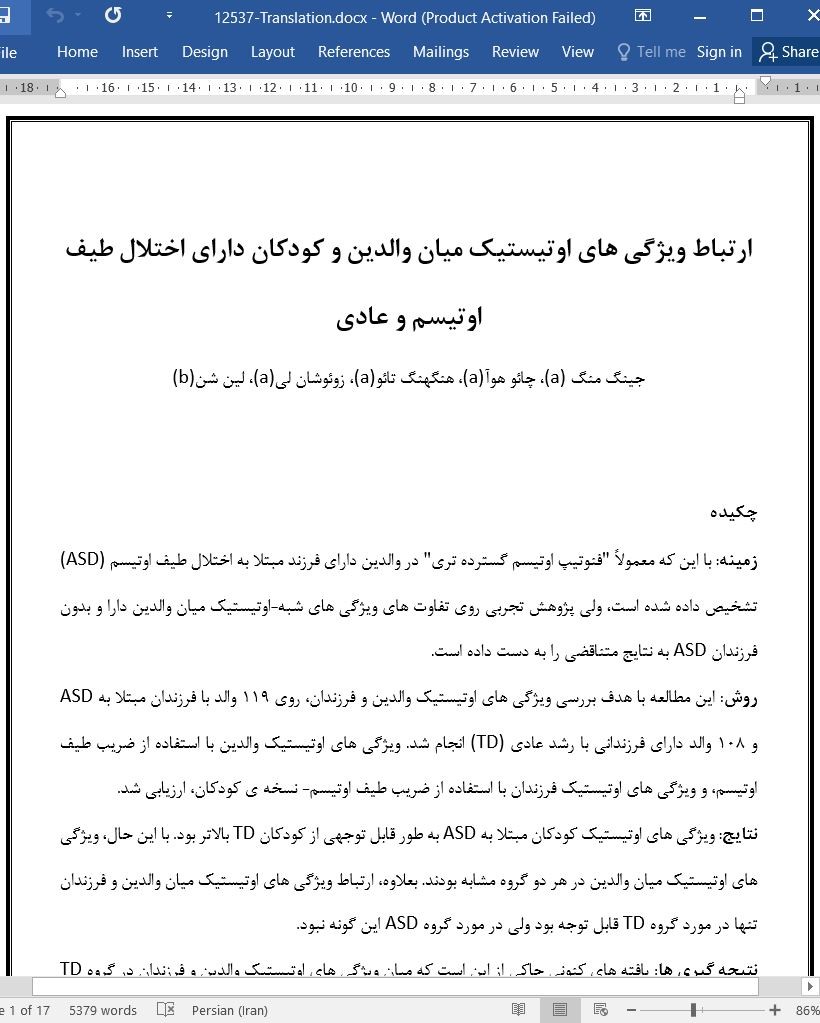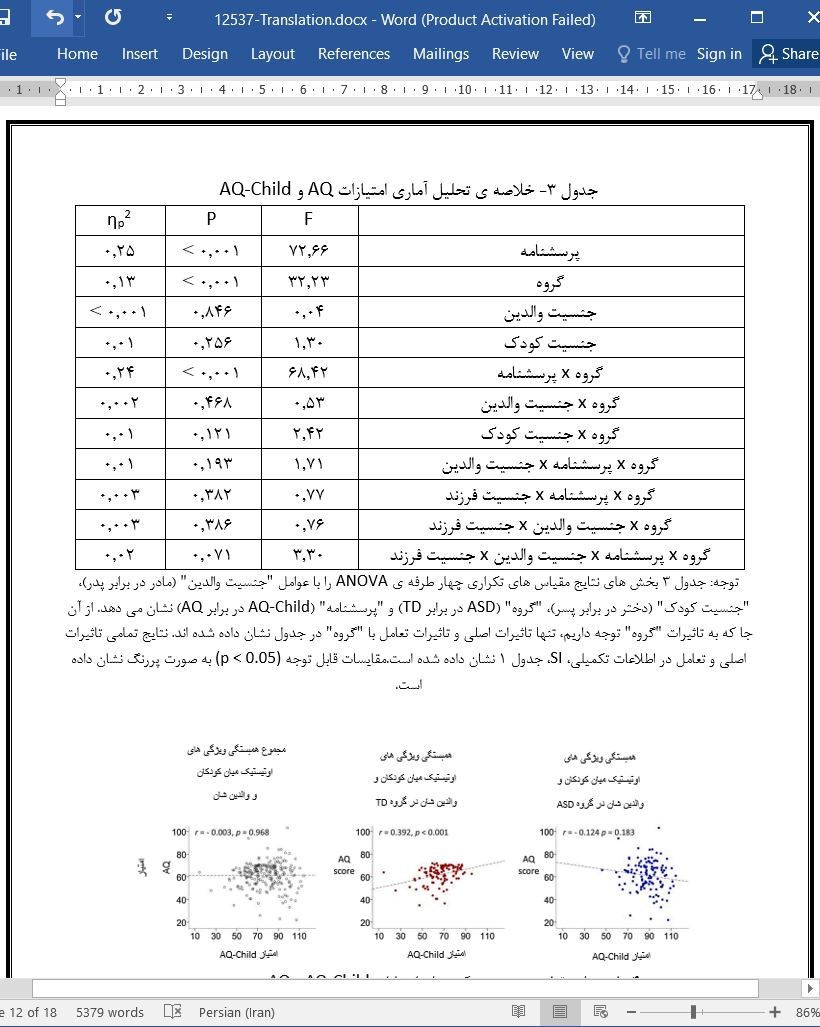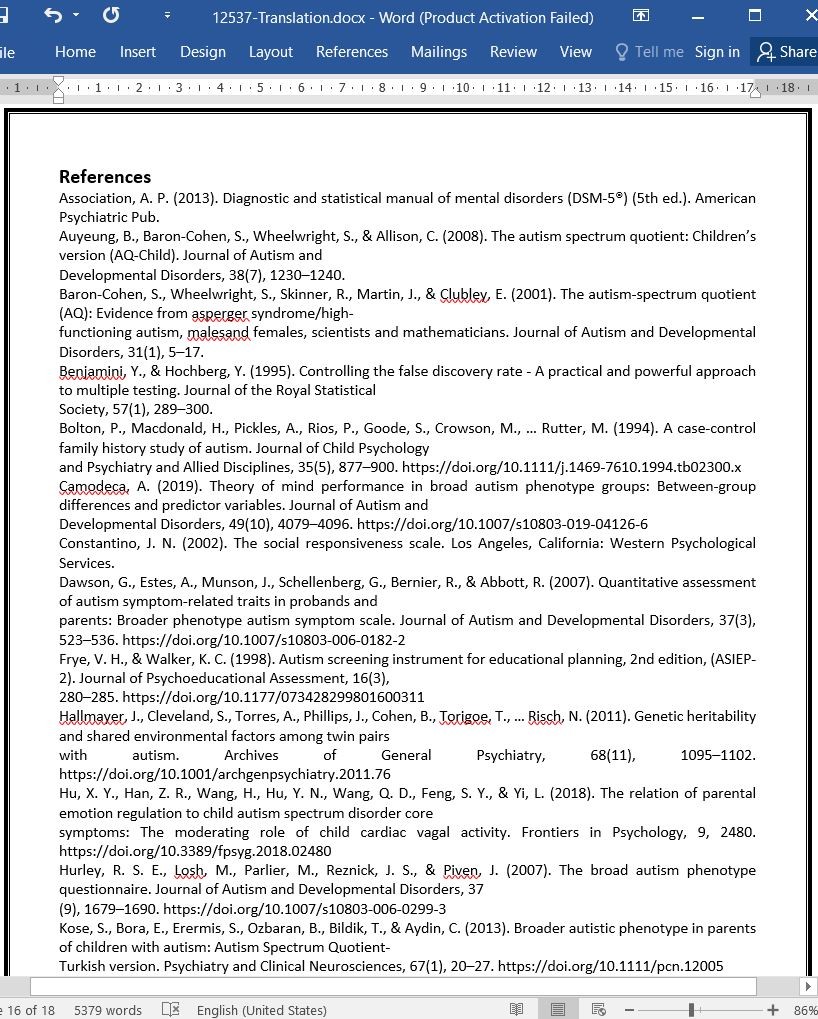
ارتباط ویژگی های اوتیستیک میان والدین و کودکان دارای اختلال طیف اوتیسم و عادی
چکیده
زمینه: با این که معمولاً "فنوتیپ اوتیسم گسترده تری" در والدین دارای فرزند مبتلا به اختلال طیف اوتیسم (ASD) تشخیص داده شده است، ولی پژوهش تجربی روی تفاوت های ویژگی های شبه-اوتیستیک میان والدین دارا و بدون فرزندان ASD به نتایج متناقضی را به دست داده است.
روش: این مطالعه با هدف بررسی ویژگی های اوتیستیک والدین و فرزندان، روی 119 والد با فرزندان مبتلا به ASD و 108 والد دارای فرزندانی با رشد عادی (TD) انجام شد. ویژگی های اوتیستیک والدین با استفاده از ضریب طیف اوتیسم، و ویژگی های اوتیستیک فرزندان با استفاده از ضریب طیف اوتیسم- نسخه ی کودکان، ارزیابی شد.
نتایج: ویژگی های اوتیستیک کودکان مبتلا به ASD به طور قابل توجهی از کودکان TD بالاتر بود. با این حال، ویژگی های اوتیستیک میان والدین در هر دو گروه مشابه بودند. بعلاوه، ارتباط ویژگی های اوتیستیک میان والدین و فرزندان تنها در مورد گروه TD قابل توجه بود ولی در مورد گروه ASD این گونه نبود.
نتیجه گیری ها: یافته های کنونی حاکی از این است که میان ویژگی های اوتیستیک والدین و فرزندان در گروه TD رابطه وجود دارد و ضریب طیف اوتیسم می بایست برای والدین به عنوان یک غربالگری کمکی به منظور شناسایی کودکانی مورد استفاده قرار گیرد که برای بررسی ویژگی های اوتیستیک نیاز به غربالگری بیشتر دارند.
1. مقدمه
اختلال طیف اوتیسم (ASD) نوعی اختلال رشدی است که به واسطه ی مشکل در تعاملات اجتماعی، بروز رفتار و فعالیت های تکرارشونده و همچنین علایقی که به طور نامعمولی محدود و سخت هستند، تشخیص داده می شود(American Psychiatric Association, 2013). ASD شمار زیادی از رفتارها و علائم را در بر می گیرد که در میان افراد مختلف، بروز متفاوتی دارد. در وضعیت بالینی، شدت ASD به صورت تسلسل وار ظاهر می شود و ویژگی های قابل ارزیابی فنوتیپ کامل اوتیسم (برای مثال، ویژگی های اوتیستیک) که در زمره ی مسائل اساسی ASD هستند، در افرادی با رشد عادی (TD) به طور مستمر توزیع شده اند (Lazar, Evans, Myers, Moreno-De Luca, & Moore, 2014).
5. نتیجه گیری
در نتیجه، این مطالعه ویژگی های اوتیستیک والدین و فرزندان را در گروه های ASD و TD بررسی کرد و رابطه ی میان آن ها را فاش کرد. یافته های جاری نشان می دهند که رابطه ی میان ویژگی های اوتیستیک والدین و فرزندان در گروه TD وجود داشت. ازین رو، AQ می تواند در والدین به عنوان یک کمک غربالگری برای شناسایی کودکانی استفاده شود که باید برای ویژگی های اوتیستیک بیشتر نظارت شوند.
Abstract
Background Although parents with a child with autism spectrum disorder (ASD) have usually been identified as having the “broader autism phenotype”, empirical research on the differences in autistic-like characteristics between parents with and without ASD children has yielded inconsistent results.
Method This survey of the autistic traits of parents and children was conducted in 119 parents with ASD children and 108 parents with typically developing (TD) children. Parents’ autistic traits were quantified using the Autism-Spectrum Quotient and children’s autistic traits were quantified using the Autism Spectrum Quotient—Children’s Version.
Results The autistic traits of ASD children were significantly higher than those of the TD children; however, autistic traits were similar between parents in the two groups. Furthermore, the correlations of autistic traits between parents and children were only significant for the TD group and not for the ASD group.
Conclusions The current findings indicate that the relationship of autistic traits between parents and children exists in the TD group, and that the Autism-Spectrum Quotient may be used for parents as a screening aid to identify children who should be further screened for autistic traits.
1. Introduction
Autism spectrum disorder (ASD) is a type of developmental disorder, diagnosed on the basis of difficulties in social interactions, the presentation of repetitive behavior and activities, as well as unusually narrow, strong interests (American Psychiatric Association, 2013). ASD involves a large number of behaviors and symptoms that vary across individuals. In the clinical condition, the severity of ASD presents across a continuum, and the quantifiable features of the full autism phenotype (i.e. autistic traits) included in the ASD core deficits are continuously distributed in typically developing (TD) individuals (Lazar, Evans, Myers, Moreno-De Luca, & Moore, 2014).
5. Conclusions
In conclusion, this study investigated the autistic traits of parents and their children in the ASD and TD groups and revealed the relationship between them. The current findings indicate that the relationship between the autistic traits of parents and children existed in the TD group. Thus, AQ may be used in parents as a screening aid to identify children who should be further screened for autistic traits.
چکیده
1. مقدمه
2. روش ها
2.1. شرکت کنندگان
2.2. تمهیدات
2.2.1. ضریب طیف اوتیسم – نسخه کودکان
2.2.2. ضریب طیف اوتیسم
2.3. تحلیل داده ها
3. نتایج
3.1. تحلیل های اولیه
3.2 تحلیل های اصلی
3.3 تحلیل همبستگی
4 بحث
5 نتیجه گیری
منابع
ABSTRACT
1. Introduction
2. Methods
2.1. Participants
2.2. Measures
2.2.1. The Autism Spectrum Quotient—Children’s Version
2.2.2. The Autism-Spectrum Quotient
2.3. Data analysis
3. Results
3.1. Preliminary analyses
3.2. Main analyses
3.3. Correlation analysis
4. Discussion
5. Conclusions
References
- اصل مقاله انگلیسی با فرمت ورد (word) با قابلیت ویرایش
- ترجمه فارسی مقاله با فرمت ورد (word) با قابلیت ویرایش، بدون آرم سایت ای ترجمه
- ترجمه فارسی مقاله با فرمت pdf، بدون آرم سایت ای ترجمه



